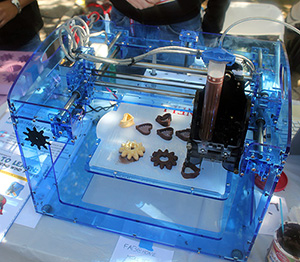|
|
|
Food Producing 3D Printers Might Feed Astronauts In the Not-So-Distant Future
by Sylvan Bachhuber, age 14

Nothing sounds more like science fiction than a box that creates an entire meal from a gel-like substance, and then literally prints it out. As crazy as it seems, scientists believe that contraptions like this may actually exist in the next 20 years.
A team at Cornell University is pioneering this food-producing technology. They have manufactured a device called the Fab@Home 3D printer, successfully producing realistic bananas, mushrooms, and cheese.
The industry of 3D printing is progressing rapidly, as engineers come up with bigger and bolder ideas. With more advanced technology, people could defy the current boundaries of food production. A Japanese company uses its 3D-printing technology to make a life-size pure chocolate replica of your sweetheart’s head. Other avant-garde ideas include cakes with logos inside, or hot dogs with ketchup and mustard in the center. The possibilities are almost endless.
A food-producing printer would be useful for space expeditions. Instead of loading up on vacuum-sealed packets of food, astronauts could bring along one microwave-sized box that printed off whatever meal their hearts desired. Having printers make foods that replicate familiar flavors could help curb homesickness while fortifying their meals with vitamins and amino acids.
Since 3D printers could customize nutrients in food products for patients with specialized needs, they would be particularly valuable in hospitals.
While the practical and helpful applications for a device like this are many, we still have a long time to go until the technology is capable of producing a large variety of foods. The existing printers can only shape a single item, because syringes are filled with a single ingredient. Take the chocolate heads for example, melted chocolate is inputted into the printer as it builds the shape up layer by layer. To actually produce a food item, engineers would have to work with many different kinds of materials in a range of textures and temperatures. To get to a point where a single printer can make more than one thing that tastes and looks like real food, we will have to wait about 5 to 10 years. It would take an additional 5 to 10 years to build a machine that could produce an entire meal.
The prospect of meal-producing 3D printers, confined to imaginations and science fiction, may soon become reality.
[Source: www.wired.com]
|
|

